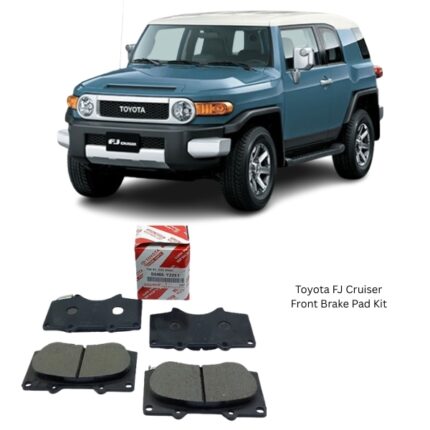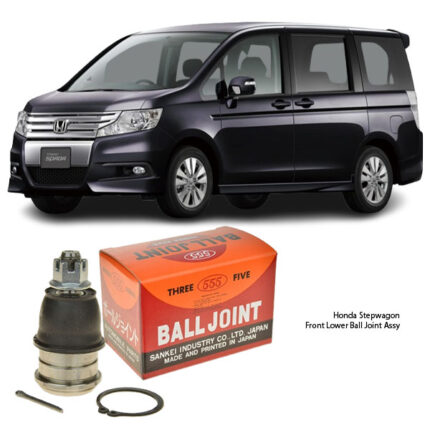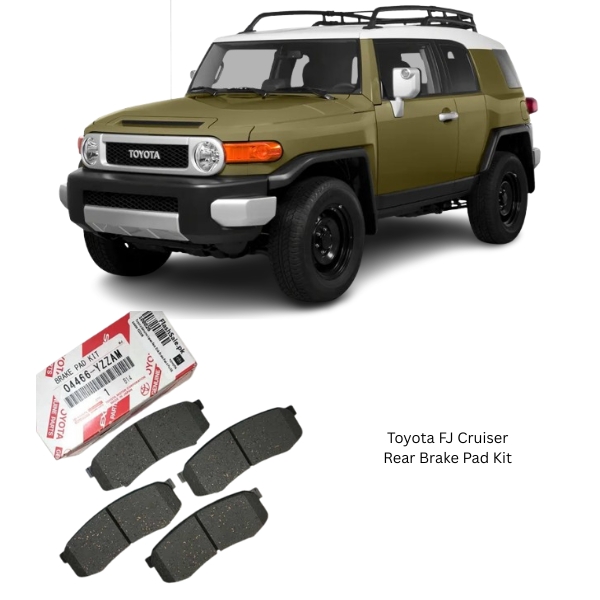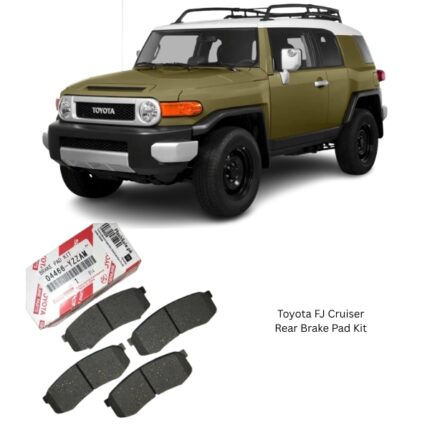-6%
Get Toyota FJ Cruiser Rear Brake Pad Kit 04466-YZZAM in Kenya
The rear brake pad kit is one of the most essential components in a vehicle’s braking system. It ensures that the car is able to slow down or come to a complete stop safely and consistently. While front brakes typically handle a larger share of the braking force, the rear brake pads play a crucial role in maintaining balance, stability, and overall stopping efficiency. Without properly functioning rear brake pads, a vehicle’s braking system would be incomplete and unsafe.
Purpose and Function
At its core, the rear brake pad kit is designed to provide controlled friction. When you press the brake pedal, hydraulic pressure forces the brake caliper to push the brake pads against the brake rotor. This friction converts the vehicle’s kinetic energy into heat, allowing the car to decelerate smoothly. The rear pads share the braking duty with the front pads, preventing the rear of the car from swaying, fishtailing, or becoming unstable during sudden stops.
Key Components of a Kit
A typical rear brake pad kit comes with:
-
Two pairs of brake pads (enough for both rear wheels).
-
Shims or anti-squeal plates, which help reduce vibration and noise.
-
Hardware such as clips or springs, depending on the design, to secure the pads in the caliper.
-
Sometimes wear sensors that trigger a dashboard warning when the pads are near the end of their life.
Having all these parts in one kit ensures uniform replacement and balanced braking performance.
Materials and Construction
Brake pads are made from different friction materials, each with its own advantages:
-
Ceramic pads: Known for smooth braking, minimal dust, and quieter operation. They also handle high temperatures well.
-
Semi-metallic pads: Contain metal fibers, offering excellent stopping power and durability. They perform well in heavy-duty or high-performance conditions but can produce more noise and dust.
-
Organic pads: Made from natural materials like glass or rubber, often softer and quieter but with shorter lifespans.
Most modern vehicles use either ceramic or semi-metallic rear brake pads, as they balance performance, comfort, and durability.
Benefits of a Rear Brake Pad Kit
-
Safety and Control – A fresh set of rear brake pads ensures that the vehicle can stop quickly and reliably, especially during emergency braking.
-
Even Braking – Replacing both pads at once ensures balance, preventing uneven wear that can stress the braking system.
-
Noise and Vibration Reduction – Modern kits are designed to minimize squeaking, grinding, and pedal vibration.
-
Rotor Protection – Worn pads can damage rotors, leading to costly replacements. New pads extend the lifespan of the rotors.
-
Better Driving Comfort – Smooth braking gives drivers confidence and enhances the overall driving experience.
Signs You Need Replacement
Rear brake pads are wear-and-tear items and need regular inspection. Some common signs that it’s time for a replacement include:
-
Squealing or squeaking sounds when braking.
-
Grinding noise, which usually indicates the pads are completely worn out and the metal backing is contacting the rotor.
-
Reduced braking performance, such as longer stopping distances.
-
Brake pedal vibrations when applying pressure.
-
Dashboard brake warning light if the pads are equipped with sensors.
Ignoring these signs can compromise safety and cause expensive damage to other brake components.
Replacement and Maintenance
When replacing rear brake pads, it’s important to follow these practices:
-
Always replace both sides (left and right) together to maintain even braking.
-
Inspect the rotors at the same time; they may need resurfacing or replacement if heavily worn.
-
Check brake fluid levels, as worn pads can affect fluid pressure.
-
Bed-in new pads by gently braking during the first few hundred kilometers to allow proper seating against the rotors.
Routine inspection, especially every service interval, ensures pads are replaced before they become a safety hazard.
Genuine vs Aftermarket Options
Rear brake pad kits are available in both genuine and aftermarket versions:
-
Genuine brake pads are supplied by the original vehicle manufacturer or their approved partners. They are designed specifically for the vehicle model, ensuring perfect fit, reliable performance, and long life. However, they often come at a higher price.
-
Aftermarket brake pads are made by independent manufacturers. They can vary in quality but often provide excellent performance at a more affordable price. Many aftermarket pads are engineered to match or even exceed original specifications.
Both options have their place, and the choice often depends on the driver’s needs, budget, and driving style.
Durability and Lifespan
The lifespan of rear brake pads depends on several factors:
-
Driving habits: Frequent heavy braking wears pads faster than gentle driving.
-
Type of terrain: Urban stop-and-go driving causes more wear compared to steady highway driving.
-
Material type: Ceramic pads generally last longer than organic pads.
-
Vehicle load: Heavier vehicles put more stress on brake systems.
On average, rear brake pads last between 30,000 to 70,000 kilometers, but regular inspections are the best way to judge replacement timing.
Importance for Vehicle Performance
While many drivers focus on front brake pads, neglecting the rear pads can compromise the entire braking system. Rear pads help distribute braking force, preventing the rear wheels from skidding or locking up. They are especially important in vehicles with advanced braking systems such as ABS (Anti-lock Braking System) and ESC (Electronic Stability Control), which rely on balanced braking at all four wheels to function properly.
Environmental and Safety Considerations
Modern brake pads are designed to minimize dust and emissions. Older pads often contained asbestos, but today’s pads are made with safer materials. Still, brake dust should be handled carefully during replacement. Many manufacturers also focus on creating pads that are quieter and produce less pollution, improving both driver comfort and environmental safety.
Follow us on Facebook for more parts.




